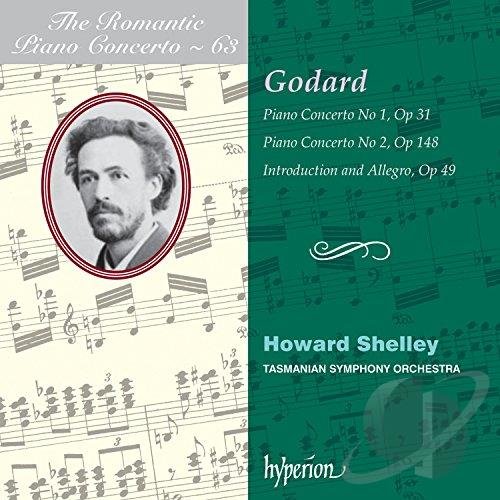
Howard Shelley, Tasmanian Symphony Orchestra - The Hyperion Romantic Piano Concerto, Vol.63: Godard (2014)
BAND/ARTIST: Howard Shelley, Tasmanian Symphony Orchestra
- Title: The Hyperion Romantic Piano Concerto, Vol.63: Godard
- Year Of Release: 2014
- Label: Hyperion
- Genre: Classical
- Quality: FLAC (image+.cue)
- Total Time: 01:10:13
- Total Size: 262 Mb
- WebSite: Album Preview
Tracklist:
Benjamin Louis Paul Godard (1849 - 1895)
Piano Concerto number 1 a-moll, op. 31 (1875)
01. I. Andante. - Allegro vivace [09:48]
02. II. Scherzo. Allegretto non troppo [04:38]
03. III. Andante quasi adagio [08:29]
04. IV. Vivace ma non troppo. - Allegro non troppo [06:59]
Piano Concerto number 2 G-dur (g-moll), op. 148 (1893)
05. I. Con moto. - Allegro. - Moderato [09:35]
06. II. Andante. - [7:17]
07. III. Scherzo. Allegretto [03:10]
08. IV. Andante maestoso. - Moderato [08:33]
Introduction and Allegro d-moll (F-dur) for piano and orchestra, op. 49 (1880)
09. I. Lento. - [5:20]
10. II. Allegro. - Allegro moderato [06:22]
Performers:
Howard Shelley (piano and conductor)
Tasmanian Symphony Orchestra
Benjamin Louis Paul Godard (1849 - 1895)
Piano Concerto number 1 a-moll, op. 31 (1875)
01. I. Andante. - Allegro vivace [09:48]
02. II. Scherzo. Allegretto non troppo [04:38]
03. III. Andante quasi adagio [08:29]
04. IV. Vivace ma non troppo. - Allegro non troppo [06:59]
Piano Concerto number 2 G-dur (g-moll), op. 148 (1893)
05. I. Con moto. - Allegro. - Moderato [09:35]
06. II. Andante. - [7:17]
07. III. Scherzo. Allegretto [03:10]
08. IV. Andante maestoso. - Moderato [08:33]
Introduction and Allegro d-moll (F-dur) for piano and orchestra, op. 49 (1880)
09. I. Lento. - [5:20]
10. II. Allegro. - Allegro moderato [06:22]
Performers:
Howard Shelley (piano and conductor)
Tasmanian Symphony Orchestra
The massive survey of Romantic piano concertos carried out by British pianist-conductor Howard Shelley -- 63 CDs and counting -- has certainly had its ups and downs, but this entry is one of the stronger in the series. French composer Benjamin Godard was prolific indeed over his 45 years, but remains known mostly for a single berceuse from the opera Jocelyn, known in English as Angels Guard Thee. Shelley makes a strong case for the recovery of the three piano-and-orchestra works included here. Godard avoided the influence of Wagner, and there are certainly many respects in which he took Brahms for a model. But he is most interesting in the places where he departs from that model, such as in the Scherzo and Andante of the Piano Concerto No. 1 in A minor, Op. 31 (1875), which develop the drama only suggested by the sonata-form first movement, or the organically developing and initially quite ominous opening movement of the Piano Concerto No. 2 in G minor, Op. 148 (1893). The four-movement structure of each concerto is novel, and Shelley handles the Tasmanian Symphony Orchestra well from the keyboard, an impressive feat given the difficulty of the piano parts. The final Introduction and Allegro, Op. 49, seems to suggest Beethovenian seriousness in its Lento introduction (track 9) but turns into something different, a joyous bravura romp. Recommended for anyone interested in the virtuoso scene of the late 19th century.
Classical | FLAC / APE | CD-Rip
As a ISRA.CLOUD's PREMIUM member you will have the following benefits:
- Unlimited high speed downloads
- Download directly without waiting time
- Unlimited parallel downloads
- Support for download accelerators
- No advertising
- Resume broken downloads


